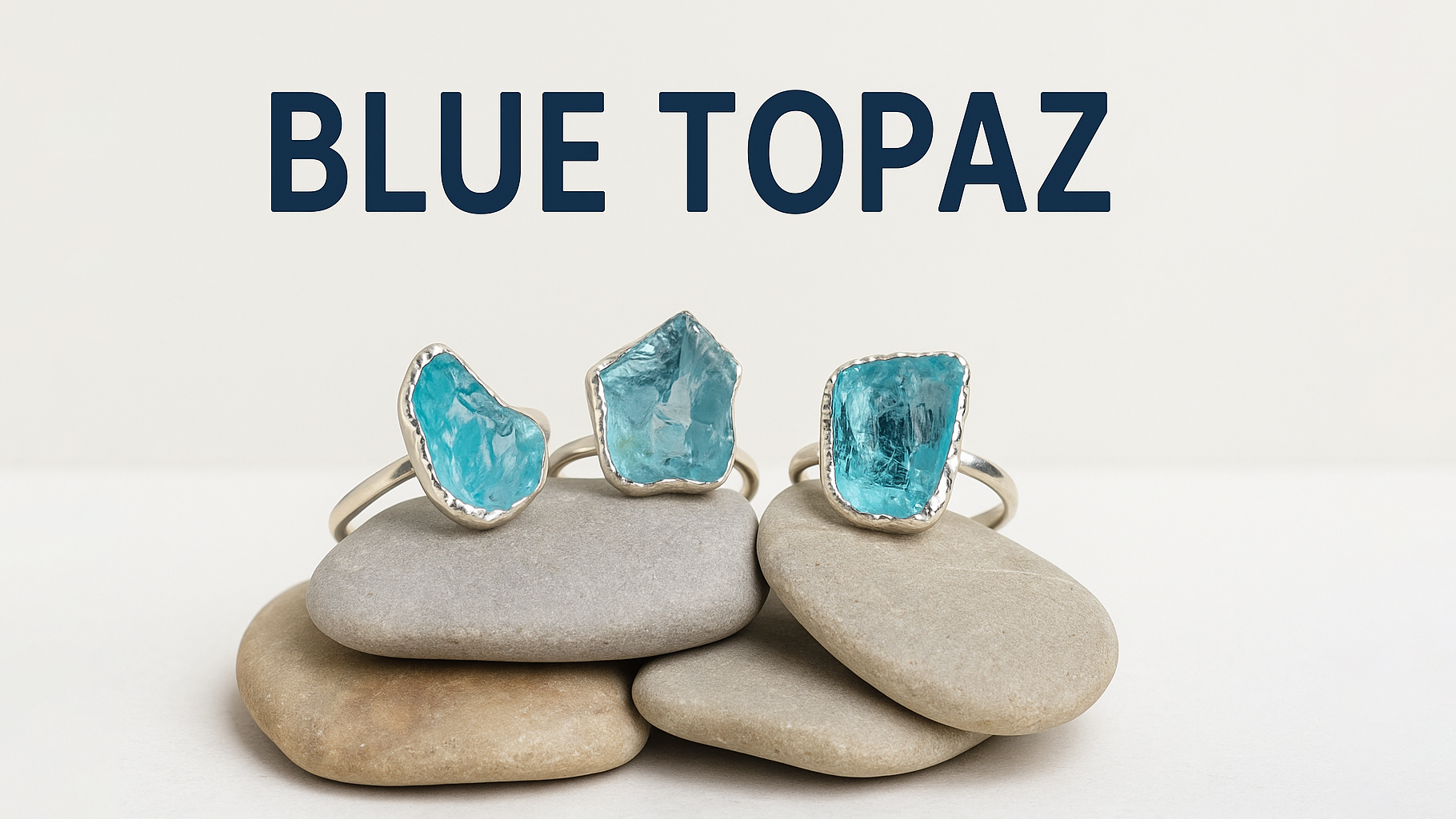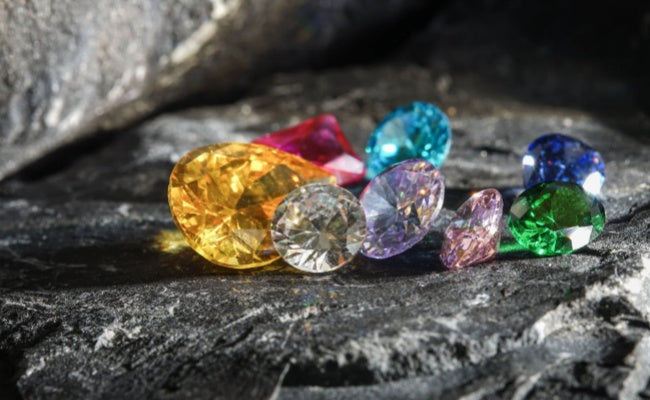
What is Blue Topaz? The Ultimate Guide to Blue Topaz
Blue topaz holds a special place in the world of gemstones thanks to its enchanting sky-blue hues and outstanding clarity. As one of December's birthstones and a traditional gift for the fourth anniversary, this beautiful gem not only dazzles with its appearance but also carries rich historical, cultural significance and practical value.
This article takes you deep into the world of blue topaz — covering how it forms, its characteristics, history, meaning, and tips for buying — offering a complete understanding of this fascinating gemstone. Whether you're a gem collector, jewelry designer, or simply someone who loves blue stones, this detailed blue topaz guide will provide you with valuable insights.
What is Blue Topaz?
Chemically known as aluminum fluorosilicate (Al2SiO4(F,OH)2), topaz belongs to the silicate mineral family and ranks among the hardest natural minerals on Earth. Blue topaz is one of the most popular varieties in the topaz family, celebrated for its captivating blue shades and impressive optical properties.
Other Physical Properties
- Mohs Hardness: 8, making it highly scratch-resistant and durable, second only to diamond (10) and corundum (9).
- Refractive Index: 1.609 – 1.643, with strong double refraction that gives it brilliant shine and sparkle.
- Density: 3.4 – 3.6 grams per cubic centimeter.
- Cleavage: Perfect basal cleavage, meaning it can break along certain planes.
- Luster: Glassy shine, extremely transparent with almost no inclusions.

What Color is Blue Topaz?
Natural topaz typically appears colorless, light blue, pink, or golden-yellow. However, most of the blue topaz we see today is actually made by treating colorless topaz with heat and radiation. This process is completely safe and has become a standard practice in the jewelry industry. The resulting colors are stable and long-lasting.
The saturation of blue topaz varies from a soft sky blue to a deep London blue, with each shade having its own unique charm. Blue topaz mainly comes in three color grades: Sky Blue Topaz shows a delicate light blue, Swiss Blue Topaz displays a moderately intense blue, and London Blue Topaz possesses the deepest blue tone with a subtle gray undertone.

What is Sky Blue Topaz?
Sky Blue Topaz is the palest variety of blue topaz, showing a clear and transparent light blue reminiscent of a clear sky. This color feels calm and pure, making it perfect for everyday wear. It has a lower color saturation, but this gentle tone gives it an elegant yet understated quality. Sky Blue Topaz is usually more affordable and is a great choice for those new to blue topaz.

What is Swiss Blue Topaz?
Swiss Blue Topaz presents a medium-deep blue, more vibrant and rich than Sky Blue Topaz, with noticeably higher color saturation. This blue has a slight greenish tint and conveys a fresh and lively vibe, much like the crystal-clear lakes in the Alps. Swiss Blue Topaz is very popular in the market because it offers enough color depth to highlight the gem’s beauty without being too dark or heavy.

What is London Blue Topaz?
London Blue Topaz is the darkest of the blue topaz varieties, showcasing a deep steel blue with a slight gray tone. This color is deep and mysterious, evoking a mature and steady impression, much like the color of the Thames River on a foggy London day. London Blue Topaz is the most expensive among the three and highly favored by collectors. It has the highest color saturation and shines with a stunning deep blue glow under sunlight.

The Treatment of Blue Topaz
There are no natural Swiss Blue or London Blue Topaz stones and their beautiful colors come from special treatments. Most blue topaz in today’s jewelry market has undergone these treatments. The process usually involves two steps: first, irradiation of colorless or light-colored natural topaz, followed by heat treatment to stabilize the color. This treatment method is the industry standard, and treated blue topaz is just as stable and durable as natural blue topaz.
Irradiation uses electron or neutron beams to change the crystal structure inside the topaz, producing the blue color. The subsequent heat treatment ensures the color remains stable and consistent. Importantly, topaz treated this way is completely safe and does not emit any harmful radiation.
Though natural blue topaz is extremely rare and expensive, treated blue topaz is equally beautiful and durable, making it the ideal choice for most buyers. When purchasing blue topaz, reputable jewelers like LUO Jewelry will clearly disclose whether the gem has been treated.
Blue Topaz History
The history of topaz dates back to ancient civilizations, where this gemstone played an important role in human cultural development. There are two main stories about the origin of the name "topaz": one traces it to the Sanskrit word "tapas," meaning "fire", reflecting ancient people's recognition of the gem's inner energy; the other links it to Topazios Island in the Red Sea, where the ancient Greeks discovered peridot stones and later mistakenly referred to topaz by the same name.
In ancient Egypt, topaz was seen as a symbol of Ra, the sun god. Egyptians believed this gemstone held sacred power to protect its wearer from evil forces. The ancient Greeks and Romans also valued topaz highly, believing it could enhance the wearer's strength and wisdom. During the Middle Ages, topaz was very popular among European nobility. People at that time thought topaz had healing powers, especially for eye ailments and mental illnesses.
However, it's important to note that natural blue topaz was extremely rare throughout history. True blue topaz only began to be recognized and appreciated in the 19th century, and even then, it was found in very limited quantities. The widespread use of blue topaz in modern times started in the mid-20th century, when scientists discovered that colorless topaz could be transformed into beautiful blue hues through radiation treatment. It was only then that blue topaz truly entered the mainstream jewelry market.

The 1970s and 1980s were a golden era for blue topaz. Treatment techniques improved steadily, production increased dramatically, and prices became more accessible. During this time, the three main categories of blue topaz — Sky Blue, Swiss Blue, and London Blue — were established. This classification system remains in use today.
Today, blue topaz is one of the world's most popular colored gemstones. Its stunning color, relatively affordable price, and remarkable durability secure its important place in the global jewelry market. From an ancient sacred symbol to a modern fashion accessory, topaz has witnessed the journey of human civilization and reflects our timeless pursuit of beauty.
Where is Blue Topaz Found?
Blue topaz is found in many places around the world. Various countries have topaz deposits, but the quality, color, and characteristics of the stones differ depending on where they come from. Knowing the traits of topaz from each location helps you better understand and choose the right blue topaz.
Minas Gerais, Brazil
Brazil is the world's largest topaz producer, especially the Minas Gerais region. The colorless topaz mined here is the main source for creating blue topaz through treatment. After processing, it can range in color from sky blue to London blue. Brazilian topaz forms in granite pegmatites, a geological environment that gives the stones excellent transparency and clarity. The crystals from Brazil tend to be large, often resulting in cuts with significant carat weight.
Sri Lanka
Known as the "sland of Gems", Sri Lanka produces topaz mostly from alluvial deposits, where rivers have worn down the stones over time, making their surfaces smooth and interiors mostly free of cracks. While natural blue topaz is rare in Sri Lanka, treated blue topaz from this region usually has outstanding clarity and vibrant color.
The Ural Mountains, Russia
Russia's Ural Mountains are another key source of topaz. This area has produced some natural light blue topaz, which, although not deeply colored, is highly valued as a natural blue topaz collector’s stone. Russian topaz is known for well-formed crystals that often retain perfect natural faces.

Texas, USA
Texas is nicknamed the "Topaz State" and its official state gem is topaz. Mason County, Texas, is famous for its uniquely light blue topaz. Although the color is pale, this natural blue topaz holds special significance.
Other Locations
In recent years, Gilgit-Baltistan in Pakistan has become a new hotspot for topaz, producing stones of excellent quality with colors ranging from colorless to light blue. African countries like Nigeria and Madagascar also have small topaz outputs, occasionally yielding high-quality specimens. China's Xinjiang and Inner Mongolia regions also have topaz deposits. China has made great strides in topaz processing and treatment technology recently, becoming an important hub for blue topaz processing.
Blue Topaz Meaning
Blue topaz is not only a beautiful gemstone, but also carries rich symbolic meaning and cultural connotations. It has been imbued with special significance and efficacy in various cultural traditions.
What Does Blue Topaz Symbolize?
Blue topaz is considered a symbol of wisdom, communication, and truth. Its pure blue color evokes the vast sky and deep ocean, representing an open heart and profound thinking. In ancient cultures, blue topaz was seen as a gemstone that could enhance a person's insight and judgment, helping the wearer make the right decisions during challenging times. It also symbolizes loyalty and friendship and is often given as a token of friendship or a symbol of love.
Blue Topaz Birthstone Meaning
Blue topaz is one of the modern birthstones for December. For those born in December, blue topaz is believed to bring good luck, health, and happiness. According to tradition, wearing your birthstone can enhance your natural talents and abilities, while protecting you from negative energy. Many people choose to wear blue topaz jewelry on their birthdays or gift it to family and friends as a meaningful birthday present.
Spiritual Healing
In the realm of spiritual healing, blue topaz is believed to calm the mind and relieve stress. Its blue energy is said to activate the throat chakra, improving communication skills and helping people express their thoughts and emotions more clearly. Many crystal therapists believe blue topaz helps release inner fears and anxiety, bringing peace and tranquility to the mind. It is also thought to boost creativity and imagination, making it especially suitable for artists or anyone who needs innovative thinking in their work.
Physical Healing
In traditional crystal therapy, blue topaz is considered beneficial for the throat, neck, and thyroid. It is believed to help soothe sore throats and improve speech abilities. Some people also believe blue topaz can relieve headaches, enhance sleep quality, and positively affect eye health.
The beauty and symbolism of blue topaz make it one of the most cherished gemstones, offering wearers emotional comfort and joy.
Blue Topaz Jewelry Design
The versatility of blue topaz makes it a favorite among jewelry designers. Its excellent hardness and relatively affordable price allow it to be used in various types of jewelry — from everyday stud earrings and simple pendants to luxurious cocktail rings.
In ring designs, blue topaz is often featured as the central stone, surrounded by diamonds or other colorful gemstones to enhance the overall effect. Its cool tone pairs especially well with white gold or platinum, while combinations with yellow gold create a warm and elegant contrast.
In necklace and earring designs, blue topaz's transparency and luster beautifully catch and reflect light, creating a captivating visual effect. Designers often combine different sizes of topaz stones to produce layered and textured pieces full of depth and charm.
How to Choose Blue Topaz Jewelry?
Choosing blue topaz jewelry involves considering several key factors. Knowing what to look for will help you find beautiful, valuable pieces that suit your style and needs.
The 4Cs Standard
When assessing blue topaz, pay attention to four main qualities:
- Color: The ideal blue topaz has a bright, vivid, and evenly distributed color. Avoid stones that look too pale or dull. Different shades of blue suit different skin tones: Sky blue looks fresh and elegant on lighter skin; Swiss blue is the most versatile, flattering most complexions; London blue has a deeper, more mature vibe, especially flattering for darker skin tones.
- Clarity: High-quality blue topaz should be very clear with no visible flaws, inclusions, cracks, or cloudy areas. Because blue topaz typically has excellent clarity, even mid-range stones should look flawless to the naked eye.
- Cut: A well-cut blue topaz shines brightly and reflects light evenly as it moves. Avoid stones cut too shallow or too deep, as this diminishes their sparkle. Top cuts also feature perfect symmetry with uniform facets and no noticeable irregularities.
- Carat Weight: Blue topaz is generally affordable, so larger stones don’t come with a steep price tag. For everyday earrings, 1 - 3 carats per stone are ideal; pendants work well with stones from 3 - 10 carats; rings often favor main stones between 2 and 8 carats.
Setting Styles
Choosing the right setting is important too. Prong settings are most common since they showcase blue topaz beautifully—just make sure the prongs don’t squeeze the stone too tightly. Bezel settings offer better protection, making them great for everyday wear. Channel settings work well for accent stones and create a continuous sparkle effect.

Metal Choices
White gold or platinum highlights blue topaz’s cool tones, making the blue look crisp and pure. Yellow gold adds warm contrast, giving a vintage, elegant feel. Rose gold pairs uniquely with blue topaz and appeals to those seeking something more personalized.
Certification
A gemstone certificate is a crucial safeguard when buying. Trusted certificates detail the stone’s features, including color, clarity, cut, carat weight, and whether it has been treated. Globally recognized labs include GIA, SSEF, and Gübelin—certificates from these authorities are widely respected.
Budget
Blue topaz is relatively budget-friendly, but prices vary with quality. Natural light blue stones are rare and costly, while treated stones offer better value. Sky blue topaz is the most affordable, Swiss blue sits in the midrange, and London blue commands the highest prices. Don’t forget to factor in setting costs — complex designs and precious metals can add significantly to the total price.
With these tips in mind, you can confidently select blue topaz jewelry that will be a treasured part of your collection for years to come.
Where to Buy Blue Topaz?
Traditional jewelry stores are the most common purchase option. The advantage of physical stores is that you can see and touch the stones in person, allowing you to directly assess their beauty. Knowledgeable sales staff can also offer detailed product information and buying advice.
Online jewelry stores, like LUO Jewelry and other specialized sites, provide a wide selection at relatively favorable prices. LUO Jewelry offers customizable Swiss blue topaz and London blue topaz collections available online, including rings, necklaces, and earrings. Every piece features carefully selected and expertly cut high-quality blue topaz. More over, these platforms typically offer detailed product descriptions, high-resolution images and videos, plus authoritative certification.
Auction houses and antique shops may offer unique vintage blue topaz jewelry with historical value and collectible appeal. However, buying from these sources requires more expertise to evaluate authenticity and worth.
Gem trade shows and exhibitions are preferred by professional buyers and collectors. Here, you can access a large selection of high-quality blue topaz often at better prices than retail. But a certain level of expertise is needed to make informed decisions.
Other Questions About Blue Topaz
Does Blue Topaz Fade?
When properly cared for, the color of blue topaz is quite stable. Under normal wear and storage conditions, noticeable fading is unlikely, and the stone can maintain its color for decades or even longer. Long-term studies by internationally recognized gem labs show that standard-treated blue topaz has excellent color stability at room temperature.
Is Blue Topaz Birthstone?
Yes, blue topaz is considered a modern birthstone for the month of December. The other two birthstones are turquoise and tanzanite stone, but blue topaz has gained popularity as a birthstone option for that month. For those born in December, blue topaz is believed to bring good luck, health, and happiness.

Is Blue Topaz Expensive?
Compared to other colored gemstones, blue topaz offers exceptional value for money, which is one of the main reasons for its widespread popularity. Even the priciest London Blue topaz is significantly more affordable than sapphires, tanzanites, and other blue gems. With the same budget, customers can buy much larger and higher-quality blue topaz stones than sapphires, making it a great choice for those who love blue gems but have limited budgets.
Conclusion
With this detailed blue topaz guide, we hope you now have a comprehensive and deep understanding of this beautiful gemstone. Blue topaz holds a special place in the modern gem world with its unique charm and practicality. Whether as a birthday gift, keepsake, or investment piece, it offers lasting beauty and value.
If you want to know more about blue topaz and blue topaz jewelry, please feel free to contact us anytime.

